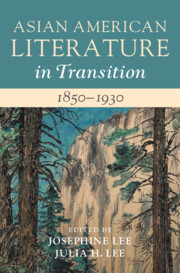Book contents
- Asian American Literature in Transition, 1850–1930
- Asian American Literature in Transition
- Asian American Literature in Transition, 1850–1930
- Copyright page
- Contents
- Illustrations
- Notes on Contributors
- Series Preface
- Introduction: Asian American Literature in Transition, 1850–1930
- Part I Empire and Resistance
- Part II Bodies at Work and Play
- Chapter 7 Objects of an Orientalist Gaze
- Chapter 8 Labor, Freedom, and Typicality in Chinese Canadian Railroad Fiction
- Chapter 9 Bret Harte’s “Heathen Chinee” in US Literature after Slavery
- Chapter 10 On the Genealogy of Asian American Drama
- Chapter 11 Decorative Orientalism
- Part III Crossings
- Bibliography
- Index
Chapter 8 - Labor, Freedom, and Typicality in Chinese Canadian Railroad Fiction
from Part II - Bodies at Work and Play
Published online by Cambridge University Press: 27 May 2021
- Asian American Literature in Transition, 1850–1930
- Asian American Literature in Transition
- Asian American Literature in Transition, 1850–1930
- Copyright page
- Contents
- Illustrations
- Notes on Contributors
- Series Preface
- Introduction: Asian American Literature in Transition, 1850–1930
- Part I Empire and Resistance
- Part II Bodies at Work and Play
- Chapter 7 Objects of an Orientalist Gaze
- Chapter 8 Labor, Freedom, and Typicality in Chinese Canadian Railroad Fiction
- Chapter 9 Bret Harte’s “Heathen Chinee” in US Literature after Slavery
- Chapter 10 On the Genealogy of Asian American Drama
- Chapter 11 Decorative Orientalism
- Part III Crossings
- Bibliography
- Index
Summary
Chinese labor was indispensable in the building of the Canadian Pacific Railroad (1881-1885), but their contemporary memorialization largely frames them in terms of national history. This approach obscures how their lives unfolded in a transnational lifeworld that was formed by the intersecting forces of capitalism, settler colonialism, nationalism, and racialization. This chapter revisits this history as a problem of literary representation by exploring how contemporary texts construct the Chinese railroad worker as what Georg Lukacs called a typical character, a formal device through which to grasp and represent a complex, dynamic social totality. This chapter then turns to a selection of fictional texts by Paul Yee in order to track how this figure enables the author to make sense of the heterogeneous forces that shaped Chinese migration to Canada. While his children’s story “Spirits of the Railway” accords symbolic recognition to Chinese workers who died during the building of the CPR, his young adult novella Blood and Iron explores the intersection between racial capitalism and kinship. Finally, his novel A Superior Man questions the ideology of nation-building by emphasizing transnational migrant routes and relationships between Chinese and indigenous peoples.
Keywords
- Type
- Chapter
- Information
- Asian American Literature in Transition, 1850–1930 , pp. 136 - 155Publisher: Cambridge University PressPrint publication year: 2021

